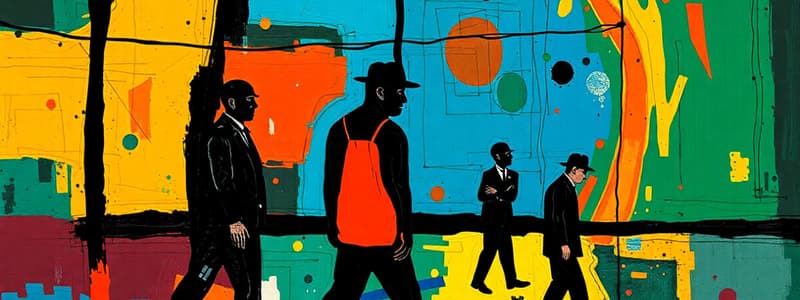Podcast
Questions and Answers
What is a key concept in the "Crime and Social Reaction" approach to understanding deviance?
What is a key concept in the "Crime and Social Reaction" approach to understanding deviance?
- Deviance is inherently defined and unchanging across cultures.
- Deviance is a product of social processes and interpretations. (correct)
- Deviance always represents a violation of the law.
- Social constructs are irrelevant to the definition of deviance.
According to the "Crime and Social Reaction" perspective, what is the significance of the fact that being poor was once considered a crime?
According to the "Crime and Social Reaction" perspective, what is the significance of the fact that being poor was once considered a crime?
- It demonstrates the inherent nature of deviance.
- It proves that poverty directly leads to criminal behavior.
- It highlights how social norms and definitions of deviance can evolve. (correct)
- It supports the idea that crime is an objective, universal phenomenon.
Which of the following is NOT a key characteristic of critical criminology?
Which of the following is NOT a key characteristic of critical criminology?
- Emphasis on the inherent nature of crime as a reflection of human nature. (correct)
- Examination of social inequalities and their impact on crime.
- Focus on the role of power in shaping the legal system.
- Analysis of how the law serves the interests of certain groups.
How does the "Crime and Social Reaction" approach challenge a purely legalistic understanding of deviance?
How does the "Crime and Social Reaction" approach challenge a purely legalistic understanding of deviance?
Which of these examples BEST illustrates the concept of moral regulation?
Which of these examples BEST illustrates the concept of moral regulation?
Which of the following statements BEST reflects the concept of "conflict crimes"?
Which of the following statements BEST reflects the concept of "conflict crimes"?
Why might a critical criminologist be interested in studying the laws surrounding private property?
Why might a critical criminologist be interested in studying the laws surrounding private property?
The Potlatch ceremony, criminalized by the Canadian government, provides an example of:
The Potlatch ceremony, criminalized by the Canadian government, provides an example of:
What role do moral entrepreneurs play in society regarding deviance?
What role do moral entrepreneurs play in society regarding deviance?
How does media portrayal influence public perception of crime?
How does media portrayal influence public perception of crime?
What is identified as a consequence of media coverage on crime?
What is identified as a consequence of media coverage on crime?
What is a key component of a moral panic?
What is a key component of a moral panic?
Why did the 'momo' become a moral panic in society?
Why did the 'momo' become a moral panic in society?
What societal shift contributed to the satanic panic of the 1980s and 90s?
What societal shift contributed to the satanic panic of the 1980s and 90s?
What type of fear did the satanic panic manifest regarding daycare centers?
What type of fear did the satanic panic manifest regarding daycare centers?
Which factor was NOT mentioned as contributing to societal moral panics?
Which factor was NOT mentioned as contributing to societal moral panics?
Flashcards
Potlatch
Potlatch
An Indigenous winter ceremony that was criminalized by the Canadian government.
Deviance
Deviance
Behaviour that is socially constructed and not inherently wrong.
Social Control
Social Control
Society's response to deviance, often more impactful than laws.
Conflict Crimes
Conflict Crimes
Signup and view all the flashcards
Critical Criminology
Critical Criminology
Signup and view all the flashcards
Moral Regulation
Moral Regulation
Signup and view all the flashcards
Social Construction of Deviance
Social Construction of Deviance
Signup and view all the flashcards
Change in Laws
Change in Laws
Signup and view all the flashcards
Moral Entrepreneurs
Moral Entrepreneurs
Signup and view all the flashcards
Media Influence on Crime
Media Influence on Crime
Signup and view all the flashcards
Moral Panic
Moral Panic
Signup and view all the flashcards
Mass Media and Crime
Mass Media and Crime
Signup and view all the flashcards
Satanic Panic
Satanic Panic
Signup and view all the flashcards
Cultural Phenomena
Cultural Phenomena
Signup and view all the flashcards
Parental Fears in Moral Panics
Parental Fears in Moral Panics
Signup and view all the flashcards
Social Shifts and Crime Perceptions
Social Shifts and Crime Perceptions
Signup and view all the flashcards
Study Notes
Criminal Justice in Canada
- Indigenous practices like the potlatch were criminalized by the Canadian government, connected to capitalism, Christianity, and assimilation
- Crime and social reaction is a sociological approach studying how deviance is constructed, and who decides what is considered deviant.
- Deviance is not inherent in acts themselves but socially constructed through processes and perceptions.
- Deviance can be contextual and vary across time and location; for example, poverty or homosexuality were once considered crimes.
- Social control methods respond to perceived deviance, and often societal disapproval is more effective than formal punishment.
- Various kinds of actions (crimes) can have different levels of consensus surrounding them.
- Some behaviours are deviant but not criminal (e.g., jaywalking) and some crimes aren't necessarily considered deviant (e.g., certain conflict crimes).
- Individuals (moral entrepreneurs) can play a significant role in shaping the perception of deviance and influencing moral norms.
Media Portrayals of Crime
- Media is a significant source shaping public perception on crime and deviance.
- People's opinions about crime often stem from media portrayals.
- Media depictions contribute to moral panics around particular groups.
- Media attention influences public perceptions, sometimes creating or exaggerating problems or events.
Moral Panics
- Problems are often identified through the media.
- Police attention draws public attention to the issue.
- Media plays a critical role in shaping and amplifying moral panics.
- Media may lead to misrepresentations or misinterpretations of events, in turn influencing public perception.
- Examples of moral panics include the Momo challenge and satanic panic.
- underlying shifts in social norms or trends can trigger fears, and media attention exacerbates these anxieties, often about children, youth, specific groups, or new technologies.
Studying That Suits You
Use AI to generate personalized quizzes and flashcards to suit your learning preferences.




